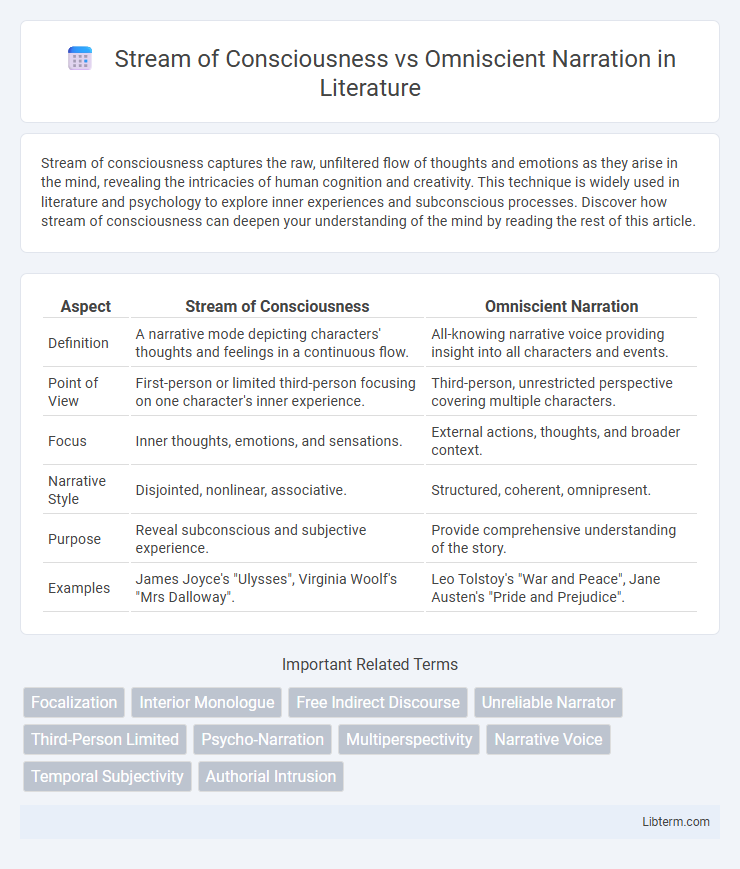Stream of consciousness captures the raw, unfiltered flow of thoughts and emotions as they arise in the mind, revealing the intricacies of human cognition and creativity. This technique is widely used in literature and psychology to explore inner experiences and subconscious processes. Discover how stream of consciousness can deepen your understanding of the mind by reading the rest of this article.
Table of Comparison
| Aspect | Stream of Consciousness | Omniscient Narration |
|---|---|---|
| Definition | A narrative mode depicting characters' thoughts and feelings in a continuous flow. | All-knowing narrative voice providing insight into all characters and events. |
| Point of View | First-person or limited third-person focusing on one character's inner experience. | Third-person, unrestricted perspective covering multiple characters. |
| Focus | Inner thoughts, emotions, and sensations. | External actions, thoughts, and broader context. |
| Narrative Style | Disjointed, nonlinear, associative. | Structured, coherent, omnipresent. |
| Purpose | Reveal subconscious and subjective experience. | Provide comprehensive understanding of the story. |
| Examples | James Joyce's "Ulysses", Virginia Woolf's "Mrs Dalloway". | Leo Tolstoy's "War and Peace", Jane Austen's "Pride and Prejudice". |
Understanding Stream of Consciousness Narration
Stream of consciousness narration immerses readers directly into a character's internal thoughts and feelings, providing an unfiltered and nonlinear flow of consciousness that mimics natural cognition. This technique reveals psychological depth by capturing spontaneous mental associations, sensory impressions, and emotional reactions, often sacrificing conventional narrative structure for authenticity. Unlike omniscient narration, which offers a comprehensive overview of multiple characters and events, stream of consciousness prioritizes intimate subjectivity and immediacy.
Defining Omniscient Narration
Omniscient narration is a storytelling technique where the narrator possesses unlimited knowledge about all characters, events, and settings within the narrative, providing insights into multiple perspectives and internal thoughts. Unlike the stream of consciousness style, which delves deeply into a single character's internal experiences, omniscient narration offers a comprehensive and all-encompassing view, often shifting between characters and times. This narrative form enhances thematic complexity by allowing readers to understand broader contexts and interconnected storylines from an authoritative, god-like vantage point.
Key Characteristics of Stream of Consciousness
Stream of consciousness narration captures a character's inner thoughts and feelings in a continuous, often disjointed flow, mimicking natural thought processes. It employs techniques like interior monologue, fragmented syntax, and free association to provide intimate access to the character's psyche. This style contrasts with omniscient narration, which offers an all-knowing, external viewpoint encompassing multiple characters and events.
Core Features of Omniscient Narration
Omniscient narration provides an all-knowing perspective, revealing the thoughts, feelings, and motivations of multiple characters, which contrasts with the subjective, fragmented insights typical of stream of consciousness. This narrative style allows the author to present a comprehensive view of events, often delivering commentary and background information to deepen the reader's understanding. By shifting seamlessly among characters and scenes, omniscient narration creates a broad, cohesive narrative structure that encompasses diverse viewpoints and thematic elements.
Advantages of Stream of Consciousness Style
Stream of consciousness narration offers a deep immersion into characters' thoughts and emotions, providing readers with an intimate and authentic experience of the protagonist's internal world. This style captures the complexity and fluidity of human cognition more naturally than omniscient narration, allowing for nuanced psychological exploration. It enhances character development by revealing spontaneous, unfiltered reflections, which can create stronger emotional connections and greater empathy.
Strengths of Omniscient Narration
Omniscient narration provides a comprehensive perspective by revealing multiple characters' thoughts, feelings, and motivations, enhancing depth and complexity in storytelling. It allows for seamless shifts in time and space, creating a broader understanding of the plot and setting. This narrative style offers clarity and insight that limits of stream of consciousness often restrict, making it ideal for intricate plots and diverse character development.
Limitations and Challenges of Both Techniques
Stream of consciousness narration often poses challenges such as maintaining reader engagement due to its fragmented and nonlinear structure, which can obscure plot clarity and character motivations. Omniscient narration, while providing comprehensive insight into multiple characters and events, risks diluting emotional intensity by distancing readers from individual perspectives. Both techniques require careful balance to avoid overwhelming or alienating readers through either excessive introspection or excessive narrative scope.
Stream of Consciousness vs Omniscient: Narrative Impact
Stream of consciousness narration offers an intimate, immersive glimpse into a character's thoughts, emotions, and perceptions, creating a subjective and fragmented narrative experience that mirrors human cognition. In contrast, omniscient narration provides a comprehensive, authoritative perspective, revealing multiple characters' inner states and broader contextual details, shaping a more structured and objective storyline. The narrative impact of stream of consciousness lies in its ability to evoke personal, emotional depth, while omniscient narration enhances thematic complexity and plot coherence by integrating diverse viewpoints.
Famous Examples in Literature
Virginia Woolf's "Mrs. Dalloway" exemplifies stream of consciousness by providing intimate access to characters' thoughts and emotions in real-time. In contrast, Leo Tolstoy's "War and Peace" employs omniscient narration, offering a comprehensive overview of multiple characters and events with an all-knowing perspective. James Joyce's "Ulysses" also showcases stream of consciousness, revealing the complex inner workings of the protagonist's mind with fluid, associative prose.
Choosing the Right Narration for Your Story
Selecting the appropriate narration style profoundly influences how readers connect with your characters and story. Stream of consciousness offers intimate access to a character's inner thoughts and emotions, creating an immersive, subjective experience that reveals psychological depth. In contrast, omniscient narration provides a broader, all-knowing perspective, allowing for multifaceted storytelling with insights into multiple characters and events beyond any single viewpoint.
Stream of Consciousness Infographic

 libterm.com
libterm.com